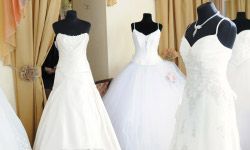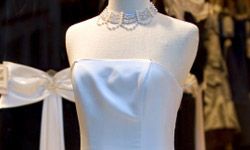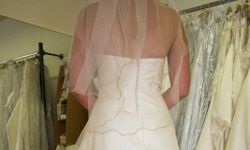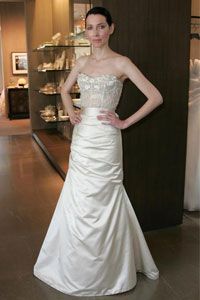Wedding gown fabrics serve a number of functions, from creating stiffness to support an overskirt, to adding sheen or an attractive drape to a sleeve, bodice or train. You may run across some fabrics you've never heard of before, or fabrics you recognize but don't understand very well. This short list will help you to begin to identify some common wedding textiles:
- Batiste -- A fine, sheer and delicate cotton or cotton/linen blend
- Brocade -- A heavy, woven fabric with a raised or sculpted design, typically only worn during cool seasons
- Chantilly -- A fine, mesh lace that often features floral designs outlined with silk threads
- Chiffon -- Sheer, mesh fabric that can be made from silk, cotton or polyester
- Crepe -- Lightweight, soft fabric that appears slightly crimped or crinkled
- Crepe de Chine -- A thinner variety of the crepe fabric described above
- Crinoline -- A stiff foundation fabric that's used as an underskirt with a ball gown style wedding dress
- Organza -- A sheer, fine, translucent and textured fabric made from silk, polyester or nylon
- Satin -- Shiny fabric that's usually very smooth and densely woven. It's available in many different weights and color.
- Shantung -- Rough-textured woven silk or synthetic fabric that crushes easily
- Taffeta -- A high-end, woven fabric with a slight sheen that's often reserved for fine garments. It's available in two varieties: Piece-dyed taffeta, which is soft and often used as a lining material, and heavier, stiffer yarn-dyed taffeta used in evening gowns and wedding dresses.
- Tulle -- Sheer, stiff mesh made from rayon, cotton, silk or nylon
- Velvet -- A fabric with a distinctive pile, velvet can be made with silk, cotton or a number of blends. It's typically a cool-weather choice.
- Voile -- Very lightweight, semi-transparent fabric woven from cotton, linen, synthetics and cotton blends
Once you can recognize the basic wedding dress designs you'll begin to see different elements, like sleeve styles, as separate components that can be mixed and matched to create unique and dramatic effects. That and an awareness of your body type and personal preferences will help you identify the perfect gown for you.



